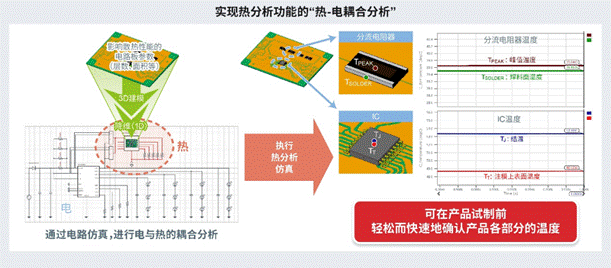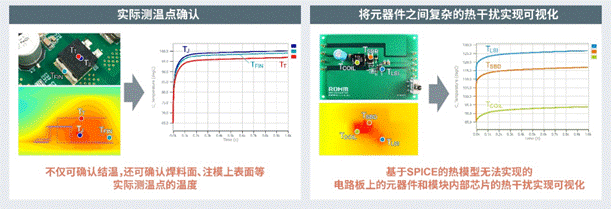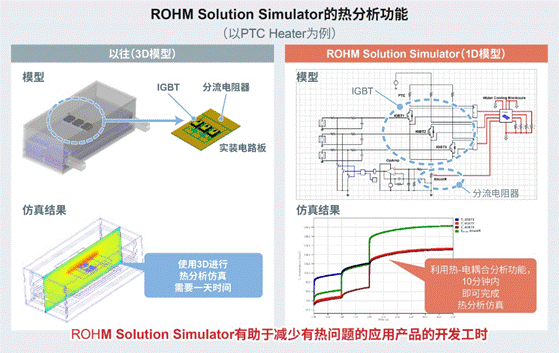What is the thermal simulation of DC-DC converter
Time:2022-12-07
Views:1475
"This thermal analysis function is to use thermal fluid analysis tools to conduct 3D modeling of the heat dissipation related parameters calculated from the actual circuit board, and reduce the 3D data to one dimension, so that thermal analysis can be conducted through the circuit simulator, thus conducting the electrical and thermal coupling analysis. The coupling analysis is a method that considers the interaction and mutual influence of two or more different influencing factors, such as electrical, thermal, and flow fields, and calculates the steady state and transient state Methods of analysis.



Key points of this article
? The thermal analysis function of ROHM Solution Simulator has the following features:
– Thermal electrical coupling analysis can be carried out for circuits containing power semiconductors, ICs and passive devices.
– In addition to the analysis of semiconductor chip temperature (junction temperature) during circuit operation, it can also analyze the thermal interference between pin temperature and components on the circuit board.
– Thermal analysis simulation that used to take nearly a day can now be completed in 10 minutes.
– Thermal analysis can be carried out easily, so sufficient thermal design can be carried out in advance, which can reduce the rework of trial production and shorten the development cycle.
In the "Thermal Simulation of DC-DC Converter" series, we will introduce how to use the ROHM Solution Simulator to simulate the circuit operation of the power circuit composed of the 80V withstand voltage, 5A output DC-DC converter IC "BD9G500EFJ-LA". We will also introduce the simulation environment and its use method that can simultaneously perform the temperature simulation of the IC and the external device Schottky barrier diode "RB088BM100TL".
What is the thermal simulation of ROHM Solution Simulator
This simulation requires the use of the new thermal analysis function in the ROHM Solution Simulator. First, I will briefly introduce this thermal analysis function to you.
The new thermal analysis function in ROHM Solution Simulator is included in the simulation model used by ROHM Solution Simulator - Solution Circuit. At present, there are 10 solution circuits with thermal analysis function, which will be gradually increased in the future. The BD9G500EFJ-LA solution circuit used here is also one of the 10 circuits.
The thermal analysis function of ROHM Solution Simulator has the following features:
? Thermal electrical coupling analysis can be carried out for circuits containing power semiconductors, ICs and passive devices.
? In addition to the analysis of semiconductor chip temperature (junction temperature) during circuit operation, the thermal interference between pin temperature and components on the circuit board can also be analyzed.
? Thermal analysis simulation, which used to take nearly a day, can now be completed within 10 minutes.
? Thermal analysis can be carried out easily, so sufficient thermal design can be carried out in advance, which can reduce the rework of trial production and shorten the development cycle.
This thermal analysis function is to use thermal fluid analysis tools to conduct 3D modeling of heat dissipation related parameters calculated from the actual circuit board, and reduce the 3D data to one dimension, so that thermal analysis can be carried out through the circuit simulator, so as to conduct electrical and thermal coupling analysis. Coupling analysis is an analysis method that considers the interaction and interaction of two or more different influencing factors, such as electricity, heat and flow field, and calculates the steady state and transient state. The schematic diagram is as follows:

In this thermal simulation, it can not only confirm the semiconductor junction temperature (chip temperature) TJ, package top surface temperature TT and solder surface temperature TFIN that have changed during the circuit operation, but also confirm the temperature of peripheral components on the circuit board and chip thermal interference inside the module that could not be confirmed by SPICE thermal model.

In this thermal simulation, it can not only confirm the semiconductor junction temperature (chip temperature) TJ, package top surface temperature TT and solder surface temperature TFIN that have changed during the circuit operation, but also confirm the temperature of peripheral components on the circuit board and chip thermal interference inside the module that could not be confirmed by SPICE thermal model.

With the ROHM Solution Simulator, the thermal analysis described above can be performed.
|
Disclaimer: This article is transferred from other platforms and does not represent the views and positions of this site. If there is any infringement or objection, please contact us to delete it. thank you! |











